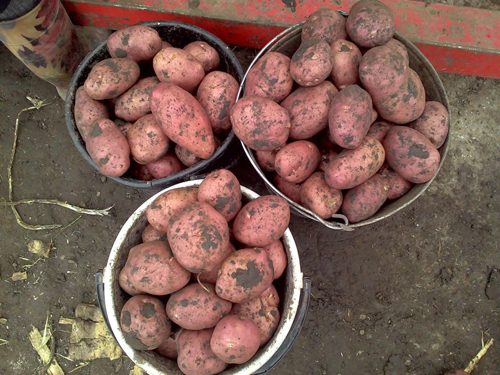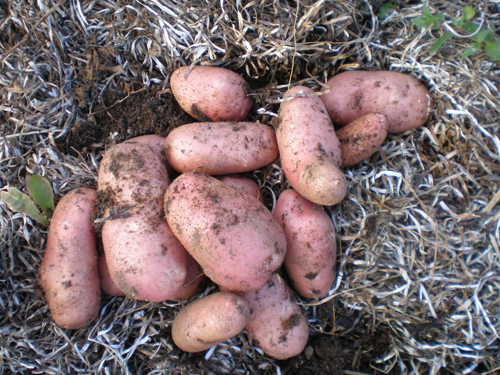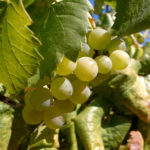Potato variety Asterix
Asterix is a medium late table potato (Solanum tuberosum) native to the Netherlands. Obtained by breeders of the company "HZPC Holland B.V." in the late 90s. It was included in the state register of plants of the Russian Federation in 1998, allowed for cultivation in two regions of the country: the Middle Volga and the Far East. Differs in stable yield, good taste and disease resistance. Recommended for industrial production of chips. Suitable for mechanical cleaning.

The period from planting to harvesting is 120-130 days, under favorable conditions and correct agricultural technology, it is possible to carry out the first digging already on the 100th day.
The plant is tall, intermediate type, erect, the amount of green mass is moderate. The leaves of the potato are medium or large, from intermediate to open type, dark green, with a slight, barely noticeable waviness at the edges. The flowers are red-violet in color, the flowering is not long, the buds often fall off.
In one nest, about 6-11 tubers are formed with an average weight of 63-109 grams. They have an oval elongated shape and a flat surface. The rind is dense, red in color, rough to the touch. The pulp is light yellow in color. There are few eyes, the depth of their occurrence is average.
During state tests, the marketable yield of Asterix was noted at the level of 137-217 c / ha, 41-121 c / ha more than the indicators of varieties Veras and Lorch... The largest amount was collected in the Republic of Tatarstan - 276 c / ha, 145 c / ha higher than Lorkh's results. According to the observations of gardeners, it is possible to stably receive about 3 kg of tubers from one plant. The marketability of tubers ranges from 71-91%, at the level of Lorkh and Veras standards. Keeping quality is quite high - 91%.
The potato tastes very good. According to the EAPR (European Association for Potato Research) classification, it is classified as culinary type B, that is, in the medium-boiling category. Suitable for cooking any kind of food, and is especially good for frying, baking, stuffing, as an addition to soups and vegetable mixtures, as well as salads. But mostly tubers are ideal for deep-frying and making chips. The pulp is medium crumbly, not watery, does not darken during heat treatment and looks very appetizing when finished. The starch content varies in the range of 14.4-16.6%, 2.4-4.1% higher than the Lorkh indicators. The amount of dry matter in the pulp is slightly increased.

The Asterix variety can grow on a wide variety of soils. The best yield, of course, he shows on light fertile soils, rich in nutrients and trace elements. Plants respond well to watering and fertilization, as well as to standard agricultural practices. The following are the main subtleties of growing this variety and caring for it.
- Seed material must be germinated before planting. This will improve the germination of potatoes and shorten the growing season. It will also be useful to treat tubers with growth stimulants and dressing agents.
- Planting is carried out when the soil warms up to + 8-10 ° C, approximately at the end of April-beginning of May.
- The planting depth is 7-10 cm, the distance between the holes is about 35 cm. The row spacing is about 70 cm.
- As mentioned above, plants respond well to watering. But do not get too carried away, they tolerate waterlogging of the soil rather painfully. In the northern regions of the country, you can do without watering at all, but in the southern regions it is necessary to protect the planting from drying out the soil.
- Asterix does not require mandatory fertilization. However, depending on the characteristics of your soil, fertilizing with potassium, phosphorus and magnesium complexes should be carried out as needed. Be very careful with nitrogen fertilizers - their increased amount leads to a slowdown in the formation of tubers and an acceleration in the growth rate of the tops.
- Do not forget about such simple techniques as hilling, loosening the soil, treating diseases and pests, weeding weeds. All these activities have a positive effect on the yield of the variety.
- It is also important to maintain crop rotation. Do not plant potatoes in an area where other nightshades have previously grown, this can lead to infection of the plants with diseases specific to this crop. The best predecessors are cabbage, zucchini, cucumber, onion, garlic, legumes, green manure.
- Update your seed in a timely manner. If this is not done, the tubers will gradually become smaller.

The variety is resistant to cancer, aureus cyst nematodes, fusarium, and many viruses. According to the originator, the tops are moderately susceptible to the late blight causative agent, while the tubers are not susceptible to it. According to gardeners, Asterix is really invulnerable to many diseases and remains unharmed in the worst seasons, while other varieties are seriously affected by diseases.
During its 20 years of existence, this potato has managed to spread quite widely across the territory of Russia. Due to its undemanding soil and climate, it is suitable for cultivation in many regions of the country. Gardeners especially appreciate it for the amicable formation of tubers, leveled in size and weight, good stable yield, unpretentious care, excellent taste and resistance to various diseases. A separate item is the suitability for machine harvesting and transportation - tubers are not subject to mechanical damage, due to which they retain their excellent presentation. Also, they are not prone to germination, so they can easily tolerate long-term storage.
There are practically no disadvantages of this variety, except that in terms of yield, it is inferior to some other modern medium-late varieties of potatoes. However, this does not prevent Asterix from remaining quite popular for many years.








